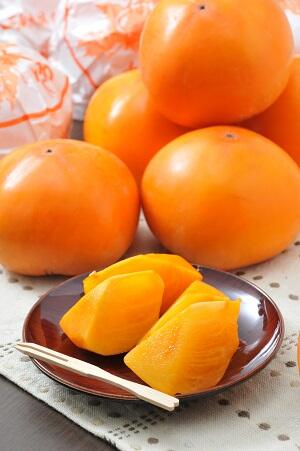Koge Hanagoshogaki
| Registration Number | 72 |
|---|---|
| Name of the GI | Koge Hanagoshogaki |
| Class | Fruit |
| Date of Protection | 2018/12/27 |
| Producing Area |
Tottori Prefecture
Yazu Town, Yazu County |
| Applicant - Name and Address | Tottori Inaba Agricultural Cooperative 1-103 Gyotoku, Tottori City, Tottori Prefecture |
Producing Area
Koge Hanagoshogaki is a domestic variety of Hanagoshogaki (Hanagosho persimmon) (1) that has been cultivated in Yazu Town (formed through merger of former Koge Town and other towns) of Yazu County in Tottori Prefecture for over 200 years.
The fruit of Koge Hanagoshogaki is quadrangular with rounded corners, and when the fruit is cut lengthways, it has a rounded heart-shape. The fruit is, characteristically, tender in virtue of fine-textured fiber, and has juicy flesh with a smooth mouthfeel. It has an average sugar content of 17 °Brix or above, some exceeding 20 °Brix.
Koge Hanagoshogaki is highly recognized for its high and stable quality achieved by cultivation management based on the fruit setting standards and by grading in accordance with own shipment standards. Koge Hanagoshogaki persimmons are in high demand as gifts.
For the production of Koge Hanagoshogaki, the cultivar Hanagoshogaki is grown in accordance with the fruit setting standards defined by the producers' group in terms of pruning, disbudding, and fruit thinning.
Harvested fruits are graded in accordance with own shipment standards in terms of fruit color, maturity, wounds, hetasuki (calyx-end fruit cracking, with a visible crack between the calyx and the fruit: results in the loss of characteristics of Koge Hanagoshogaki, including fruit appearance), fruit shape, and size before shipment.
The variety Hanagoshogaki used for the production of Koge Hanagoshogaki is thought to have originated from grafting a twig of Goshogaki (2) onto a variety of shibugaki (astringent persimmon). This twig was brought back from Yamato no Kuni (Yamato Province) (3) by Gorosuke Noda, a resident of Hana section of Yazu Town, in the Tenmei era during the Edo period (4).
In the producing area, Yazu Town, the shallow soil with an underlying layer of pebbles made it possible to grow persimmon trees into shapes that allowed for easy harvesting even from young age. This contributed to active cultivation of Goshogaki in the area.
In 1909, the variety was named Hanagoshogaki after the name of Hana section. As part of the branding strategy, the variety was later named Koge Hanagoshogaki in 1969 by adding "Koge" from the name of the area of production, Koge Town, and Koge Hanagoshogaki was defined as Hanagoshogaki that meets the newly specified standards in terms of fruit color, maturity, wounds, hetasuki, fruit shape and size.
Koge Town was merged into Yazu Town in 2005, and since then, a diverse group of stakeholders in the area, including producers, have worked together for regional development centered on Koge Hanagoshogaki.
- Hanagoshogaki: Thought to have originated from grafting, onto a variety of shibugaki (astringent persimmon), a Goshogaki twig which was brought back from present-day Nara Prefecture in the Tenmei era (1781-1789) by a farmer Gorosuke Noda from former Koge Town.
- Goshogaki: A variety of persimmon from Gose City, Nara Prefecture, which is considered to be the ancestor of amagaki (sweet persimmon) varieties in Japan.
- Yamato no Kuni: A name used since ancient times to refer to a geographical area of Japan that corresponds to present-day Nara Prefecture. The designation "Kuni" was abolished in 1871 as the country entered into the Meiji era.
- Edo period: A period of Japanese history extending from 1603 to 1867, under the shogunate established in Edo (present-day Tokyo). With Ieyasu Tokugawa as the first shogun, the Tokugawa family ruled the country thereafter under a system of centralized feudalism.


